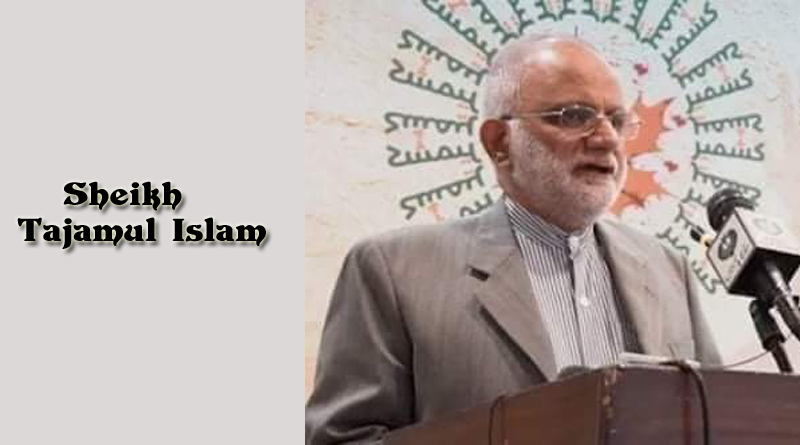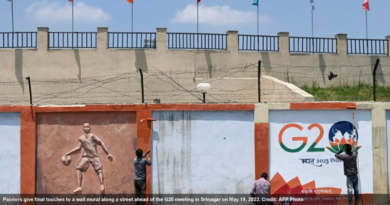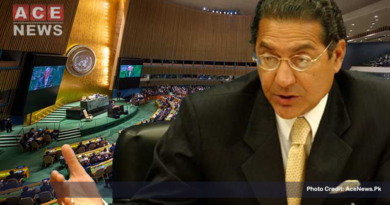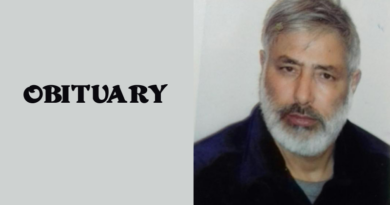Sheikh Tajamul-Islam of Barzulla Bhaghat, Srinagar, Occupied Kashmir
This is not an obituary or a tribute to the late brother, I can’t do that, i am not coming to terms with what has happened, and find it incredibly difficult to deal with the reality. I could only imagine Br Tajamul a living person full of life, energised and energising, ever exuding confidence. He was to me what nobody else is. He in Islamabad, me in London, we had different spheres of day-to-day practical involvements, but what in the first place—back in early 1980s—formed the foundation and ever since continued to animate our relationship, was our shared vision of the future, sense of the past, particularly the post-prophetic Islamic/Muslim past, and concerns arising from the present, particularly from the post-1989 freedom movement of Kashmir. We used to put the best of our intellectual energies into imagining the reformative strategies. As said, I would not write ‘about’ Br Tajamul, but there is a moral compulsion that drives me: Sheikh Tajamul-Islam’s real role in Kashmir’s freedom politics needs to be brought out. The aim here is not to confer any titles or honours on the late brother, but simply to educate serious seekers of truth, and our coming generations on the freedom history of Kashmir. This has become ever more necessary as a frame of reference has been created within which everything is assessed, and evaluated. Here I am referring to post-1989 Freedom Movement (hereafter also referred to as ‘current movement’ or ‘the Movement’) . Who did what, who is how tall a leader and who is not, all this valuation takes place relative to this frame. Now this poses a problem, both, at intellectual and practical levels, and let us briefly explain how:
First, as a general principle, for any political movement anywhere, one cannot properly understand the facts and realities of that movement unless viewed in its totality, its real time-space frame. Kashmir movement is no exception, it (as an anti-occupation movement) started in one form or the other right from the day India occupied Kashmir in 1947. Taking the current movement (post-89) as the frame of reference will amount to truncating the real time span. That being a universal consideration, there are some important features specific to the current movement, which would further strengthen my argument that this movement should not be taken as the frame of reference to determine who did what with regard to the Kashmir issue.
The distinctive and defining aspect of the current movement is that of armed militancy which in the first place kick-started the movement in 1989. Given the fact that anti-India politics had always enjoyed mass support, and high moral ground in Kashmir, the militancy directed against Indian occupation enjoyed even higher. The movement has structurally evolved ever since( please note my intention here is not to describe the current movement as such but only to highlight those aspects which render it incapable of serving as an authentic frame of reference) adding to itself a political umbrella constituted by All Party Hurriyat Conference(APHC) plus other political outfits outside APHC. Let us note some main points about this Movement relevant to our purpose here:
1) With an unprecedented political profile , the Movement claimed all the pro-freedom/anti-India political space making the already existing parties/people therein almost invisible. The ecosystem thus created made these parties seek shelter in the newly created system-the Movement, and this involved adjusting their individual profiles to the profile of the Movement.
2) Acting as a shelter, the Movement effectively became a leveller. People had to be cut to its size, and the ‘leaders’ within it became teammates . Thus the late Abdul Ghani Lone– a former Congress minister in India’s puppet regime in Kashmir—- and late Syed Ali Shah Geelani, a leading anti-India Islamic-political figure were placed on the same pedestal by the Movement as ‘Huriyat Leaders’. Actually, the latter would be heard many a time hailing the former as a valued teammate.
3) Sheltering and levelling point to a yet bigger truth about the Movement, namely, that those pushed in , did not drive it—-simply because they were not its architects—-the Movement drove them, it had its own modus-operandi, and a definite view of its historical purpose, which in turn means the future-visions of individual participants/leaders—if they had any—did not matter nor did their wishes and capability to play a role of their choice—as leaders do—in Kashmir’s political history. To make this more intelligible, particularly the point about the Movement having its own modus-operandi and sense of historical purpose, let me touch upon some Kashmir-specific facts:
We will raise a simple question: The current movement started in 1989, APHC somewhere in 1993, three decades down the line where is the institutionalized freedom politics in Kashmir? With the first gunshot in 1989, the Kashmir-India power equation started changing. India’s powerful grip acquired through decades of overt and covert control, continued to loosen by the day as young boys went on confronting India’s military might. More and more political spaces for the freedom movement became available with the hitherto available spaces becoming further radicalized. In short, the reality on the ground progressively underwent a process of change in favour of Kashmir and against India. A new political reality started emerging on the ground overwriting the one that was manufactured in 1947, and nurtured by deceit and force since then. In terms of institutionalized grass-roots political presence, where and in which concrete form is this new reality now reflected— three decades down the line—- that is the question. Which party or parties represent it? The question is about mere existence, not practical activism. Unfortunately the political landscape in terms of institutionalised political presence on the ground has hardly changed since 1947. The Pro-accession-to-India forces then created political organisation on ground, and essentially that is what continues to exist till date. What then have the Movement’s politics been all about? Well anything but not those ‘natural’ things like reaping the benefits brought in by the change on the ground, consolidating the gains and make them permanent by institutionalizing them, and thus changing the political landscape. Its historical purpose did not include that.
4) Two conclusions follow from (1)-(3) above.
First, the current movement cannot be a yardstick to measure the political size of leaders because they are there as a result of their original sizes being reduced or enlarged to fit the master frame. But that regardless, is not hugely important: political stature is more of a valuejudgment than an objective reality; political role is the real objective reality that can define someone’s worth in historic terms.
Second—and this is more important— we cannot determine the political role and contribution, in historical terms, of individuals linked to Kashmir’s freedom movement by looking at their activism in the Movement alone. Actually, activism within the Movement is more about performance, less about role—the word understood in a more comprehensive sense. Political role is driven by a conscious will arising out of beliefs and convictions, and is a matter of independent choice—one chooses to take up the role. The choice can only be exercised in a political environment where freedom does not mean merely to choose from, but to imagine new options, new visions of the future, and the strategic roadmaps. In a system like the Movement which had its set goals not designed by those in it , roles get automatically assigned by default, and the relevant question to ask is how best one performs in the given role. The question about the role itself—- who played which role, constructive or destructive—- does not arise.
What I have said about the Movement so far is precisely meant, not to devalue the services of those inside it—which deserve due appreciation— but only to elucidate my argument that to correctly understand the political role of individuals in the history of Kashmir’s freedom movement, and to determine the worth and historical significance of that role, the Movement is not the right time-frame. This applies to everyone who had a political role in Kashmir, but right now we are talking about Sheikh Tajamul-Islam, and in doing so, I will not attempt a political biography of his, but will only bring up what I, as a keen observer of freedom movement and not his associate, believe are his core contributions of historic significance to the cause of Kashmir’s freedom, and are singularly his—he basically fathered them.
One, as ‘Nazimi-a’ala’ President of Islami Jamiati-talaba (IJT)he brought the Kashmir Issue to the forefront of Islamist politics—the politics practiced by Jamaat-Islami and other like-minded outfits. To fully understand and appreciate what this meant in political-historical terms, we need to look at the following two facts:
(i) First, any Islam-inspired or oriented politics at that point in time when Tajamul-Islam made the intervention, originated from Jamaati-Islami’s political thought. Jamaat had pioneered the movement, right from its inception in 1954, of connecting politics to the religious consciousness of Muslims in Kashmir. At the practical level Jamaat pursued the goal of ‘iqamat-i-deen’ establishment of the religion. This program however did not include active struggle for the liberation of Kashmir. The conceptual, ideological or practical reasons for this are a matter of scholarly research, and is besides the point here, but to further elucidate, it is worthwhile to recall what once the late Syed Ali Geelani said summing up the Jamaat position. It was 1980 or around there, the Students Islamic Movement of India(SIMI)—–since banned by Government of India—- was holding its All India Conference in the central Indian city of Nagpur. I was then a doctoral student at the university of Pune, and was at the conference as a member of SIMI. Geelani sb spoke at the conference, and we Kashmiri students studying in India and participating in the conference, later requested him to have a separate—- kind of closed session—- with us which he kindly did. In response to our queries/requests/complaints of why Jamati-Islami is not putting Kashmir issue at the forefront of their politics, Geelani sb said—and I very vividly remember it—-‘ we have the vision and goal of establishing Islam, and within that goal we look at the issue of Kashmir, accordingly place it, and give it as much attention as it deserves’. One may agree or disagree with that but Geelani sb had a point which, however, is outside the purview of our discussion here. What, however, needs to be noted is what hitherto this non-inclusion of Kashmir in Islamist politics meant in practical terms: any well-meaning person who wished to fight India’s occupation of Kashmir before anything else, had to find a place in other Muslim but non-Islamist organisations. No wonder then, there had been such organisations—big and small, open and secret—-such as Plebiscite Front, Young Men’s League, Al-Fatah, Peoples League etc etc who would take up the liberation of Kashmir as their main goal but were either secular or to some extent Islamic but certainly not Islamist in the sense that they did not pursue a program of establishing Islamic rule, at least not in the Jamaat paradigm. With Br Tajamul’s articulation of Kashmir issue, and that too in a very powerful manner—given his exceptional oratory skills, and political charisma—it was for the first time that the liberation of Kashmir found its way in the Islamist politics and narrative in Kashmir. Br Tajamul’s person(coming from Jamati-Islami background) and new brand of politics created a fusion of Kashmir-centric politics with the Islamist narrative. The two slogans, namely, ‘Neither East Nor West, but Islam’ , ‘Oh Tyrants, Oh Usurpers, Leave our Kashmir’ became integrated into a single political consciousness. This linkage chronologically followed the Islamic Revolution of Iran in 1979 which pushed Islam to the forefront of global political discourse. In Kashmir this linkage (of Kashmir’s liberation with Islam, not necessarily with Islamic Revolution of Iran) is a very noteworthy thing to have happened as it explains all the subsequent events and historical developments that followed. Following Tajamul’s intervention IJT would in the subsequent years shape the Islamist narrative on Kashmir. The leaders of Islam-oriented political outfits would make statements or incorporate articles in their party’s constitutions that ‘ Kashmir issue is the biggest obstacle in the way of establishing ‘deen’ Islam’ which by implication meant putting Kashmir’s liberation on the front burner.
(ii) After Sheikh-Indra accord of 1975, and establishment of Sheikh Abdullah’s regime in Kashmir, a political lull ensued for quite a few years. It was for the first time the lull was broken by an announcement (somewhere in 1980) to hold a world conference on Kashmir by Islami Jamiat-e-Talaba led by Sheikh Tajamul-Islam. This created a huge furore in Indian national politics and media. Mrs Gandhi, the then Prime Minister of India—-the most powerful and ruthless Indian Prime Minister ever, spoke about it in the national parliament. I was then a doctoral student at the university of Pune, and could see the headlines flashed out by India’s national dailies. It was as if Kashmir issue was being resurrected with renewed energy, and this time unlike the past, from an Islamic platform.
Two, Sheikh Tajamul-Islam considerably raised the profile of Islamist politics in Kashmir through the way he conducted politics. It was a direct, bold, and radical way of dealing with things, a politics with teeth. I call it militant politics. Two instances deserve mention:
(i) IJT under the leadership of Tajamul-Islam in early 1980s played a historic role in opposing elections and the electoral process in Kashmir. Election boycotts have a long history in Kashmir, but it was for the first time that Islamic argument and jargon were used by Tajamul to create a formidable movement of opposing the electoral process. This was happening at a time when Jamati-Islami, viewed in public perception as an Islamic party had been in the electoral process for quite some years. This had effectively created an Islamic legitimacy for participating in elections—voting or contesting. Tajamul-Islam’s argument came from within the ideological framework of Jamati-Islami. In a detailed paper that was widely circulated in Kashmir, he quoted chapter and verse from Maulana Maudoodi’s works to substantiate his anti-election argument. While it gave a boost to other Islam-oriented outfits in their anti-election campaign, it, as an unintended consequence, created a tension between Jamat and IJT, particularly the person of Br Tajamul who mainly took the brunt of this tension. I was then doing Ph.D in Pune, but those around Br Tajamul at the time know better about it. That being relevant in its own way, the point of core importance here is, a powerful and well-articulated campaign against elections gave Kashmir-centred Islamist politics a radical profile, and it came to represent the revolutionary edge of the Kashmir’s freedom politics as a whole. This was a new happening as hitherto Islamist politics were characterized by an image of docility.
(ii) In October 1983 a One Day International Cricket match was played between India and West Indies in Srinagar. This turned out a disaster for India till eternity with the then Indian captain Kapil Dev vowing they will never again play in Kashmir. It was a highly charged crowd with young boys in the lead who jeered at Indian players. The highlight of the event was removing of the wicket during the lunch break which a young man did who was later arrested. He was not a member of IJT but like any other young man inspired by IJT and Br Tajamul. Reportedly when asked , under interrogation, as to why he did it, he responded ‘for the Pleasure of Allah’. This speaks volumes and illustrates my earlier point that IJT shaped the narrative on Kashmir after Tajamul’s powerful articulation of this issue from an Islamist platform. What has been said above somehow bears upon the evolution of Islamist politics in Kashmir, so one might reasonably ask what happened after then? How did Islamist politics evolve thereafter? These are basically the issues for serious scientific deliberation, so cannot be addressed here. However, they are also natural queries of a genuine thinking mind. I will, therefore, briefly make some basic submissions here:
Tajamul-Islam, after being imprisoned several times, ultimately decided to go underground and in the end he left Kashmir around 1984 after handing over the charge of IJT to me. The political profile of IJT did not continue for the simple reason that I was not Tajamul-Islam, did not try to be— always being my own man, and I focussed on the ideological side. The whole point was to come out of narrow, partisan interpretations of Islam and the change envisaged by it, and to become a part of the global Islamic movement which was then being redefined and reinvigorated by the late Imam Khomeini under the banner of the Islamic Revolution. However the identity of IJT as the most radical anti-India group continued to survive, so much so that when the Movement started in 1989 India had serious suspicion that IJT was behind it. The truth is it was not involved anywhere in designing, planning, and organizing it, but India was right in the sense that the radicalised Islamic consciousness which Tajamul-Islam had initiated formed the raw material that the Movement consumed, particularly in its takeoff stage. Tajamul’s child ‘the militant politics’ would have followed its natural growth trajectory, but there was no such space left for it to grow; the Movement, as earlier said, claimed the whole space.
That was ‘about’ Tajamul-Islam—-a few pages but took me ten days to do, an incredibly ‘difficult’ job because I had never ever thought in my life I will have to do this.
London: 17th Sptember, 2021.
About Blogger:
Dr. Syed M. Inayatullah Andrabi is the founder convenor of Mahazi-Islami, Occupied Kashmir. He is an intellectual-political activist from Srinagar, capital city of occupied Kashmir.




